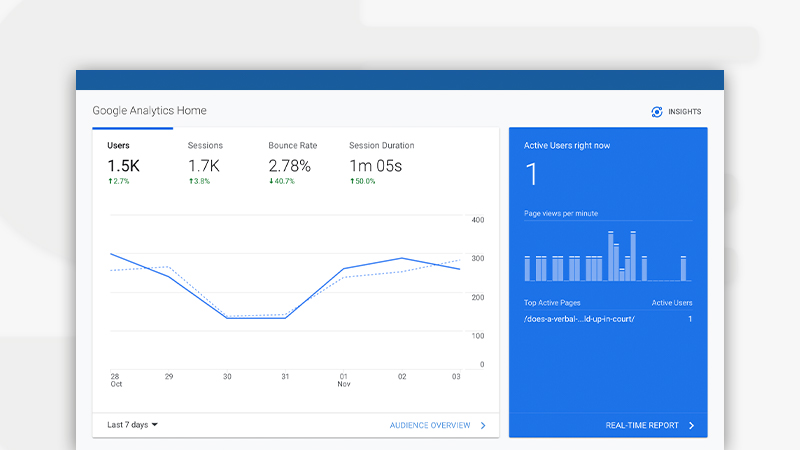Content is one of the toughest elements of your marketing to get right. Why? Because there is very little practical information out there on the steps you can take to generate website visitors.
I’ve lost count of the number of blogs I’ve read that say nothing more than to create content and hope for the best.
That’s all very well for websites that are already established online, but for smaller businesses and new websites, that advice is next to useless. After all, you can create all the high-quality content you like, but if no one finds it, what’s the point?
Sadly, many businesses do all the hard work in creating their content but don’t see any benefit because they are unaware of the steps they need to take afterwards.
Finding practical steps to improve my own content marketing was one of the most frustrating learning experiences I undertook as a marketing novice. That’s why I’ve put together some of the simplest steps you can take to improve your own.
Step 1: Take the Leap of Faith

The number one reason content marketing fails for most businesses is that they aren’t aware of the commitment required to make it work. Therefore the first step to content marketing excellence is deciding whether you have the time, resource and patience to make it work.
We all want results for minimum spend and for this reason, content marketing is a highly attractive alternative to pay-per-click advertising (PPC). Thousands of regular website visitors for only the price of a few blogs? Why would you say no?
What often isn’t explained is the time content marketing takes to generate results. Any business that is spending money on their marketing understandably wants to see returns, but content comfortably takes six to twelve months to generate meaningful results.
Below are a couple of graphs to describe what I mean. The first is the way many businesses assume content marketing works.

In this graph, the number of blogs you right directly corresponds to the results you receive from your marketing. That means a business should see the impact of their content marketing investment from day one. If only this was the case.
In reality, content marketing works much more like this:

In the first months of your content marketing, you’ll likely only see a small increase in website traffic and no meaningful impact on customers. That is because it takes time to build enough momentum online to truly be rewarded by Google.
The problem is that by around month three or four, most businesses start to wonder what they are paying for. Sadly, many then take their investment away from content marketing to implement quick ‘fixes’ that will provide immediate returns.
Unfortunately, this type of short-term marketing strategy rarely generates results. In fact, all it does is mean the time and money you put into your content is wasted.
All in all then, if you want to benefit from content marketing, it means you need to be in it for the long haul, through the good times and the bad. Of course, when you do get results (and you will), you really get results.
So, are you ready to take the content marketing leap of faith?
Step 2: Quantity or Quality?

One of the most difficult elements of content marketing is the vast array of different strategies to choose from.
With so many content marketers employing slightly different tactics, it can be difficult to know where to start. Plus, since content marketing takes a few months to get off the ground, you can easily become demotivated and lose faith in your strategy, even if it is correct.
One of the most common questions when putting together a marketing strategy is whether you should focus on quantity or quality? While there are marketers that live resolutely in one camp or another, most land in the middle and say that you need a little of both. Let’s look at both camps.
Quantity
As much as we like to think we can outsmart Google, no one has a guaranteed method for ranking on the search engine. I’ve written blogs that rank number one for a keyword within a month, and others that barely rank at all, each with a similar keyword.
In business, we always want to know the outcome before we invest, but in reality, there is always an element of hit-or-miss in any content marketing strategy.
Therefore, you’re always going to need some quantity, as you can’t rely on any single piece of content. If you have a team capable of producing content, particularly blogs, you should aim for a minimum of two blogs a week. In comparison, someone like Neil Patel aims for six a day!
If you don’t have the in-house capabilities to produce content, you’ll need to recruit an agency to do the bulk of it. If you have a low budget for this recognise that you’re going to have to support the agency by providing them with your industry expertise and writing additional content where you can.
All too often, I hear from prospective clients that they’re paying £500-£1000 per month for a blog or two and not seeing any results. Of course not, this simply isn’t enough content.
Quality
Quality is much harder to nail down than quality, which is why so many blogs pump out the same types of content over and over again. Before you even start thinking about a blog title, you need to review what your customers are actually interested in.
You can write flawlessly, but if you don’t nail down your customer needs and challenges, you’re never going to be able to delight them with content that is useful to them.
Once you have an idea of what your customers want, it’s time to do a little bit of industry research to see what content already exists in that topic and how popular it is.
Buzzsumo is a great tool for this as it lets you search topics and see what the most popular posts on social media are. This tells you the types of content that are most popular with audiences and allows you to identify styles of title that resonate with your audience.
If you’re unsure what topic to look at, you can search a competitor instead and view their most popular posts. This will give you some ideas about what you should be writing about. You can then take that idea, tailor it to your customers’ needs and put your unique spin on it.
If you find a popular post made by a competitor last year, you can provide an updated version and then even tell everyone who liked your competitor’s traffic about your newer (and better) content.
In short, then, don’t forget that quality is determined by a piece of content’s core concept, so take the time to come up with unique content that is relevant to your audience. If you don’t put enough time into coming up with valuable ideas, you’ll just end up churning out the same generic text time and time again.
When it comes to actually write your content, aim for a minimum of 1,000 words per blog. Anything less and you’re unlikely to have any chance to make it to the first page. Google likes long-form content, so if you can hit 2000 words, even better.
Step 3: The Dos and Don’ts of Keyword Research

Ever have one of those days where you think you’ve only been working on something for a few minutes, only to look at the clock and find hours have flown by?
For me, this used to happen every time I conducted keyword research. I could spend hours searching for that elusive, perfect keyword, blissfully unaware of the time I was wasting.
Keyword research is an essential part of content marketing if you’re a small company or have a website with a low authority, but you need to be practical about what you’re trying to achieve.
I used to follow a keyword strategy that targeted search terms with extremely low Google result numbers. That means less than 100,000, which may seem like a lot, but is barely anything when you consider most keywords have tens of millions.
The logic here was simple: fewer results means less competition and a higher chance of ranking on page one.
And in fairness, this technique did work. I still remember the joy I felt when I launched my first website and ranked number five for the keyword “keywordspy alternatives”.
What I didn’t realise at the time was the post gave me no value. Although I was ranking, my target audience was people who are new to marketing and in my pursuit of the perfect keyword, I’d forgotten the number one rule of content marketing: make sure everything you write is relevant to your target audience.
So, what’s the point of this story? Keyword research is useful, but don’t ever let it supersede the importance of writing content that is relevant to your target market.
If you have a great blog idea but can’t find a keyword to go with it, don’t let that stop you. Content marketing is about creating collective value, and there are other ways than Google to produce visitors (which we’ll come onto).
Other than this, the usual rules apply. Try to find a relevant keyword to include in your title tag. If you’re don’t have an established website, target long-tail (more than three words) keywords that have lower monthly search volume and lower competition. There are loads of paid tools you can use to do this, but if you’re starting out, stick with Google Keyword Planner. It’s free and effective.
Step 4: Always Remember to Review

So, you’ve been writing blogs for a few months, now what? Keep writing? Give up? Is there another option?
Treat every blog you write as if it were your child. You put all that time and effort into raising it, are you going to just send it out into the big bad world and forget about it? Of course not, you’re going to check up on it every now and then.
Reviewing how successful your blogs are is an essential part of content marketing. Once a blog has been live for about three months, you’ll want to check how successful it is.
This means looking at these metrics:
- What keywords it is ranking for
- How many impressions it’s had
- How many clicks it’s had
- It’s overall click-through rate
All this can be done through Google’s Search Console, and it is this step that will help you take your content from mediocre to exceptional.
Start by heading to the Search Console and go to Performance. From this view, you can view all of the pages on your website and order them by impressions, clicks and rankings.
What we’re looking for here are blogs that have a high number of impressions, meaning they’ve been seen on Google, and a low click-through rate, meaning not many people are reading your content.
These are the posts you’re going to want to focus on, because they have the potential to provide you with a high amount of traffic, but are not currently doing so.
Once you’ve chosen a post, click on it and then click Queries. This will show all the Google search terms that have led to impressions or clicks on your blog.
At this point, hopefully, you’ll see that you’re ranking for the keyword that you originally targeted, but you’ll likely also see dozens of related keywords that produce impressions.
In fact, you might find that another keyword is producing more impressions on your blog than the one you originally chose. In this case, go back and rewrite your content title to include this new keyword.
At the same time, increase the length of your content and include all the other relevant keywords that are generating impressions or clicks on your content.
Just take a moment to think about how valuable this step is. When you first wrote your blog, you had no idea how Google would view it, and what it would rank for. In short, you didn’t know what Google wanted and you were stabbing in the dark.
Now, Google is telling you exactly what it thinks of your content, providing you with a list of keywords and a road map for optimising your content. That’s why your initial keyword research does not have to be so in-depth. Take the time to review your blogs and Google will give you a list of keywords to optimise it for.
As mentioned, this is a technique designed for blogs that are currently underperforming, but you should also use it for your best-performing blogs. Just be careful to monitor whether it’s working. If you take a popular blog and change the title to improve it, you might inadvertently reduce its success, so you’ll want to change it back.
Finally, if you have a blog that is not ranking for keywords and producing very few impressions, there’s not much point trying to optimise it further. However, that doesn’t mean it won’t rank and be viable for this technique in the future.
Step 5: Don’t Forget You’re a Content Marketer

What’s the difference between a blogger and a content marketer? A blogger knows how to write content, but a content marketer knows how to leverage it.
A common complaint from businesses is that while content marketing may work for companies with high authority websites, for those with unestablished websites, no one ever sees their content.
The power is in your hands to make sure this doesn’t happen. Most marketers are used to sharing content on social media, but there is so much more you can do.
- You can use Ahrefs to identify the backlinks of people who linked to similar content and email them to share your blog.
- You can guest blog on other people’s websites or give interviews on podcasts to grow your brand name.
- You can answer questions and share your content on forums.
- You can target social media influencers who have shared similar content and ask them to promote yours.
- You can send out new blogs to your email database, and even ask your database what you should write about next.
The whole point of content marketing is to start a conversation with your target customers. It doesn’t make much sense then to write a piece of content and not share it.
Conclusion
You’ll notice that in this blog, I never once gave advice on how to actually write a piece of content. That’s because you don’t have to be a great writer to be a great content writer.
When a reader visits your website, they’re not looking for Shakespeare, they’re looking for valuable information they can take away with them. Nail this and follow the steps I’ve laid out and you’ll be on your way to content marketing success in no time.
That said, if you’re new to content marketing or haven’t seen great results in the past, you can never get enough advice. As a reward for making it to the end of this blog, we’re offering you a free Digital Workshop to help you identify opportunities to improve your content and marketing strategy as a whole. Book yours here.







